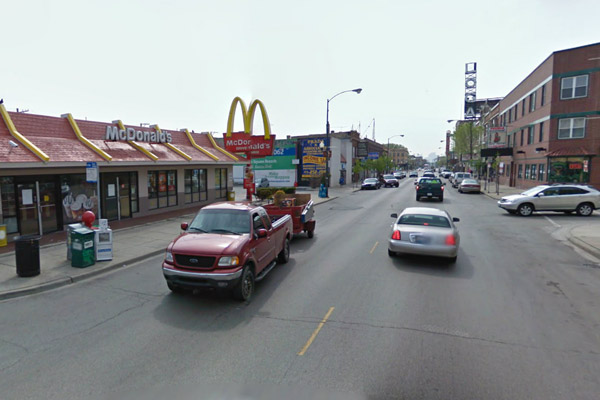
Over at his great transportation-oriented blog Steven Can Plan, Steven Vance has a long post about the destruction of a Logan Square McDonald's, the construction of a new one, and how that impacts local zoning regulations…
…ok, I know, zoning. But it does shed light on a little-appreciated aspect of the city code, and how we legislate the way our city looks. The pedestrian-street zoning regulations are among the more interesting in our books, actually.
First, a street has to meet certain requirements to be a pedestrian street in the first place. They're sensible: "have a high concentration of existing stores and restaurants"; "continuous or mostly continuous pattern of buildings that are built abutting or very close to the sidewalk"; "many storefront windows abutting the sidewalk"; and so forth. Milwaukee/Damen/North is a good example.
Then it starts getting picky:
The entire building façade that faces a designated pedestrian street must abut the sidewalk or be located within 5 feet of the sidewalk.
Recessed entries are subject to the following standards:
(a) The entrance width may not exceed 12 feet or 5% of the building’s street-facing façade width;
(b) The entrance depth may not exceed the entrance width; and
(c) The entrance may not exceed 2 stories in height.
And how:
17-3-0504-C Transparency.
1. A minimum of 60% of the street- facing building façade between 4 feet and 10 feet in height must be comprised of clear, non-reflective windows that allow views of indoor commercial space or product display areas. This standard applies to building façades that face pedestrian streets.
2. The bottom of any window or product display window used to satisfy this requirement may not be more than 4.5 feet above the adjacent sidewalk.
3. Product display windows used to satisfy these requirements must have a minimum height of 4 feet and be internally lighted.
In other words: you have to have lit windows that people can see in, and you have to let people see through them. What's the big deal? Logan Square-based planner Lynn Stevens shows the difference between conforming and non-conforming facades, and how window signs—like grocery-store price signs—can violate the principle of (literal) transparency.
It's interesting to me because, in this ordinance, you can see the traces of New Urbanism and its emphasis on density, pedestrian friendliness, and street-level commerce. But the theories of people like Jane Jacobs, who so affected the evolution of the city in the second half of the 20th century, have to be translated into rules, and this is an exquisite example: to promote commerce as part of the vitality of the city, the pedestrian-street designation literally forces stores to put as much merchandise as possible right up next to the sidewalk and to light it up besides. Hence the tight specificity on entrance size: a big entrance minimizes the available space for product display windows, so it's limited to 12 feet or five percent of the building.
As Vance describes, drive-through services like McDonalds are pedestrian-unfriendly because they work against building and retail density, and encourage street traffic to go across the sidewalk (the current McDonald's was grandfathered in). And the McDonald's rebuilt raises other questions, like whether other non-conforming work would be done while the designation is lifted.
The theorists who invented and promoted New Urbanism revolutionized the way we see cities. But coming down from the bird's-eye view, its battles are fought not just block by block, but curb cut by curb cut.
Image: Google Maps


